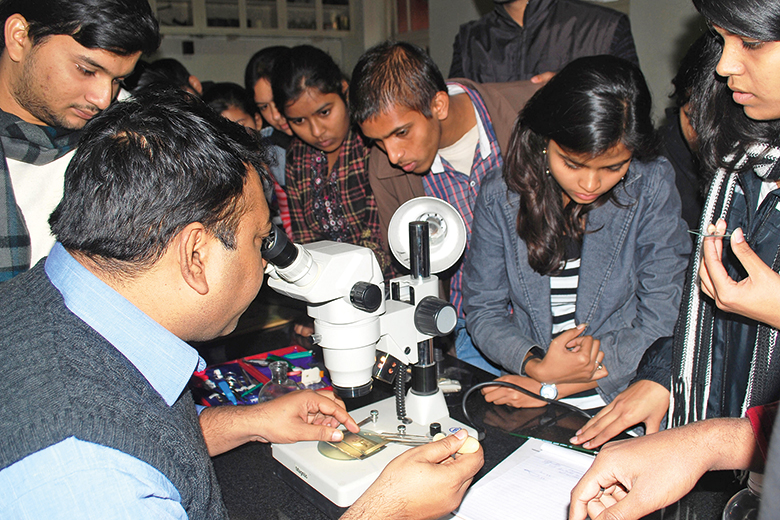Browse the full Asia University Rankings 2017 results
The Indian higher education system is undergoing a revolution – one that is much needed. A transformation is essential to shake off the decline that has crept in since the days when the world’s first formal universities were established in Takshila and Nalanda in India, when brilliant scholars travelled from afar to learn and when India was the hotbed of knowledge creation starting from the development of the concept of zero.
In pre-independence India, there were only 20 universities and some 500 colleges. In the past 70 years, the number has reached about 750 universities and more than 35,000 colleges. India is a country of large and mind-boggling numbers.
In terms of number of higher education institutions, India leads the world. With about 30 million students, it has the third highest enrolment figures, trailing only the US and China.
Despite such immense numbers, something has been starkly missing – the country has no institution among the top 200 in the Times Higher Education World University Rankings, its number of Nobel laureates is in the single digits and its research output is negligible when compared globally.
Whereas quantity – in terms of number of institutions and students enrolled – was, and perhaps still is, the focus for Indian higher education, the urgent need to dramatically improve quality is now being felt everywhere.
What does the future hold for Indian higher education in terms of numbers? In the next 10 to 15 years, the country will have more than 150 million people between the ages of 18 and 23 (the typical age of students).
To cater for this and to increase the gross tertiary enrolment ratio (GTER) from the level of about 15 per cent to something more respectable compared to the developed world (where GTER ranges from 50 per cent to 80 per cent), the government of India had estimated back in 2010 or so that 1,500 more universities would be needed.
As it became clear that the government alone would not have capacity to achieve this expansion, the push to allow more private universities to be established and to allow foreign universities to operate in India was strengthened. Although more than 150 new private universities have been set up in the six years, the foreign universities bill has been a non-starter.

Claim a free copy of the Asia University Rankings 2017 digital supplement
As the number of institutions will keep growing to meet the demands of the country, what is most important for the future is to transform how higher education is governed and run in the country.
To succeed, current and future graduates need to be inquisitive and must possess critical thinking skills and an innovative, entrepreneurial mindset. The present system of rigid, lecture-led, one-way communication and rote learning is not conducive to this.
The academic system has to change towards flexible credit systems that allow a student freedom to choose what to study within a framework. These credits must be transferable between institutions through some national structure to allow for student mobility.
Teaching has to become more participative, and more emphasis must be placed on self-learning. Whereas internationally a student might spend three hours in self-study for each hour in class, a student in India might spend less than one.
In India, where forward-looking change is occurring and the revolution in higher education is taking place, the progress is being driven by the new private universities – because they have the autonomy needed to overhaul traditional methods.
Universities also have to look at least 10 years into the future to gauge what knowledge and skills graduates will require, or to visualise what new career avenues will be available. Traditional universities take so long to revise and update the curriculum that they are not even able to keep up with the present on what needs to be taught, never mind the future.
Indian higher education also needs to interact and align more closely with industry. This could take the shape of “industry-led academic institutions” – institutions set up in partnership between industry and universities that go beyond businesses merely advising on aspects such as what to teach, to having their professionals actively involved in the delivery of education.
Amity University has taken a lead in India by starting three such institutions: the RICS School of Built Environment, Amity University; Amity Institute of Technology, a joint initiative with Tata Technologies; and CII School of Logistics, Amity University.
For the first time, industry leaders such as the UK’s Royal Institution of Chartered Surveyors, Tata Technologies and the CII (the Confederation of Indian Industry, the largest industry association in India) have joined hands with a university to educate industry-ready professionals.

One of the main reasons why Indian universities fare badly in international rankings is their low research output. Academics need to be pushed into the publish-or-perish culture; before that can happen, however, the research infrastructure must be upgraded – its neglected state is a major factor in why some of India’s most brilliant brains leave the country.
Research requires huge amounts of funding. A typical top-ranking global university will have an annual research fund of at least $1 billion (£800 million). Although the Indian government dispenses large amounts of funds for research through various agencies, a few things need to happen for Indian universities to get any level playing field.
The country’s business sector must join the government in funding research at universities. Globally, this is very common, but at the moment Indian industry lacks faith in the universities’ capabilities and does little to support their research efforts.
This issue comes back to the quality of research infrastructure and talent. One problem is the way that government universities are funded through an input-based block grant that is increased arbitrarily based on inflation or on the whims of the University Grants Commission (a body that has long been on the government’s hit list to be abolished). Funding for research should be normative, based on outcomes. It should also be separated so that it can be focused on certain institutions to help them catch up globally.
Technology will, of course, be the greatest game changer in higher education, not only in India but also around the world. Flipped classrooms and blended learning are already the norm in most leading universities, but for every person who predicts the end of bricks-and-mortar universities there is a romantic traditionalist who believes that universities are more about friendship and social skills than actual knowledge.
As India grapples with the need to widen access to higher education substantially while also increasing quality and making a mark on the world stage, one thing is clear – the future looks bright. And not-for-profit private universities will play a large role in that.
Atul Chauhan is chancellor of Amity University.
POSTSCRIPT:
Print headline: Private foundations
Register to continue
Why register?
- Registration is free and only takes a moment
- Once registered, you can read 3 articles a month
- Sign up for our newsletter
Subscribe
Or subscribe for unlimited access to:
- Unlimited access to news, views, insights & reviews
- Digital editions
- Digital access to THE’s university and college rankings analysis
Already registered or a current subscriber?







